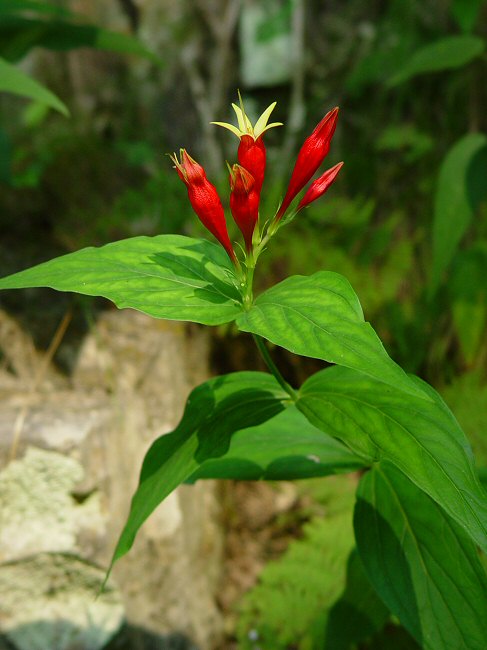Spigelia marilandica (L.) L.
Indian Pink

Native
CC = 8
CW = 5
MOC = 12
© DETenaglia
Spigelia marilandica (L.) L.Indian Pink | |
 |
Native CC = 8 CW = 5 MOC = 12 |
© DETenaglia |
|
Family - Loganiaceae Habit - Rhizomatous perennial forb. Stems - Ascending to erect, to 70 cm, multiple from base, unbranched or few-branched, minutely hairy at and around the nodes, otherwise glabrous.
Leaves - Opposite, sessile, decussate, simple. Blades mostly 3-12 cm long, the lowermost few pairs often highly reduced, ovate to lanceolate, tapered to a sharply pointed tip (the reduced lowermost ones sometimes blunt or rounded), mostly rounded to truncate at the base, the upper surface glabrous, the undersurface (and the margins) minutely hairy along the main veins.
Inflorescence - Unbranched or few branched, terminal one-sided spikes to 10 cm long.
Flowers - Calyces 7-13 mm long, the lobes linear, gradually tapered to a sharply pointed tip. Corollas 30-60 mm long, roughly trumpet-shaped, bright red on the outer surface, yellow on the inner surface, the 5 lobes spreading or curved outward, the throat glabrous. Stamens 5, alternating with the corolla lobes, slightly exserted. Filaments 6-7 mm long, white, glabrous. Anthers yellow, 3 mm long. Pistils notched or 2-lobed at the tip, the style usually shed before the fruit dehisces. Style white, glabrous, 4 cm long. Ovary superior, 2-locular, yellowish, 1.1 mm long, 2 mm broad, glabrous. Placentation axile.
Fruits - Capsules 5-8 mm long, deeply 2-lobed, dehiscing longitudinally between the lobes and along the opposite margins, the valves eventually shed, leaving a shallow cuplike base. Seeds 2.0-2.8 mm in the longest dimension, irregularly rectangular to elliptic or nearly circular in outline, more or less rounded on the dorsal surface, the other sides angular, attached on the ventral side and forming ball-like masses, the surfaces roughened or with small flat irregular tubercles, dark brown, not shiny.
Flowering - May - August. Habitat - Bottomland and mesic forests, streambanks, pastures. Origin - Native to the U.S. Lookalikes - None when flowering. Other info. - This striking and unmistakable species is found in Missouri mostly in a handful of southeastern counties. Its range is restricted to a dozen or so states in the southeastern U.S. THe plant is easy to identify from its red and yellow flowers, which resemble nothing else growing wild in the state. Photographs taken of Hwy C, Reynolds County, MO., 6-5-04, and at the Walls of Jericho Wildlife Management Area, AL., 6-25-05 (DETenaglia); also at St. Joe State Park, St. Francois County, MO, 5-31-2010, Poplar Bluff Conservation Area, Butler County, MO, 5-15-2016, and Shaw Nature Reserve, Franklin County, MO, 6-21-2021 and 8-26-2021 (SRTurner). |